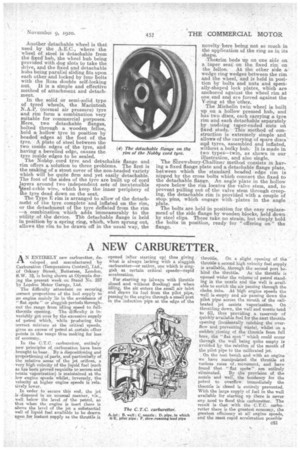A NEW CARBURETTER.
Page 15

If you've noticed an error in this article please click here to report it so we can fix it.
AN ENTIRELY new carburettor, developed. and manufactured by 'Carburation (Temperature Control) Ltd., of Orkney Street, :Battersea, London, S.W. 1£3, is being shown at Olympia during the present week on. Stand No. 257 by London Motor Garage, Ltd.
The difficulty attendant on securing coned proportions of the fuel supply to an engine mainly lie in the avoidance of " flat spots" or sluggish periods through-. out the range from idling speed to full
throttle opening. the difficulty is invariably got over by the excessive supply of petrol which, while producing taw correct mixture at the critical speeds, gives an excess of petrol at certain other points in the range thus making for loss of economy.
In the C.T.C. carburett.er, entirely new principles of carburation have been , brought to bear. By a clispoaitioning and proportioning of perts, and particularly of the relative areas of the jet orifices, a very high velocity of the liquid fuel (such as haS been proved requisite to•secure and retain vaporization) is maintained at the low engine 'speeds whilst, inversely, the velocity at higher engine speeds is relatively lower.
In order to secure this end, the jet is-disposed in an unusual manner, viz.,. well below the level of the petrol, so that when the engine is inert there is above the level of the jet a substantial well of liquid fuel available to be drawn upon for instant supply as the throttle is
opened (after starting up) thus giving what is always lacking with a sluggish carburetter—or rather, one which is sluggish at certain critical speeds—rapid acceleration.
For starting up (always with throttle closed and without flooding) and when idling, the air enters the small air inlet and draws its fuel from the pilot pipe, passing to the engine through a small port in the induction pipe at the edge of the throttle. On a slight opening of the throttle a second high velocity fuel supply is available, through the second part be hind the throttle. As the throttle is opened wider the volume of petrol standing in the nozzle and the well is available to enrich the air passing through the choke tube. At high engine speeds the well isempty and air passing down the pilot pipe across the mouth of the calibrated jet assists vaporization. On throttling down, the well and nozzle tend to fill, thus providing a reservoir of quickly a,vailable fuel for the next throttle opening (incidentally catching the overflow and preventing" waste), whilst on a sudden closing of the throttle from full bore, the "flat spot" which could occur through the well being quite empty is • avoided 1;er the relation of the mouth of the pilot pipe to the calibrated jet.
On the test bench and with an engine we have manipuleted the throttle at • various rates of movement-, and have found that "flat spote" areentirely eliminated. BY the provision of the nozzle and well", the tendency for the petrol to overflow inuriediately the throttle is closed is entirely prevented. With the large supply of fuel in the well available for starting up there is never any need to flood this carburetter. the result is that with the C.T.C. carburetter there is the greatest economy, the greatest efficiency at all engine speeds, and the most rapid acceleration possible




























